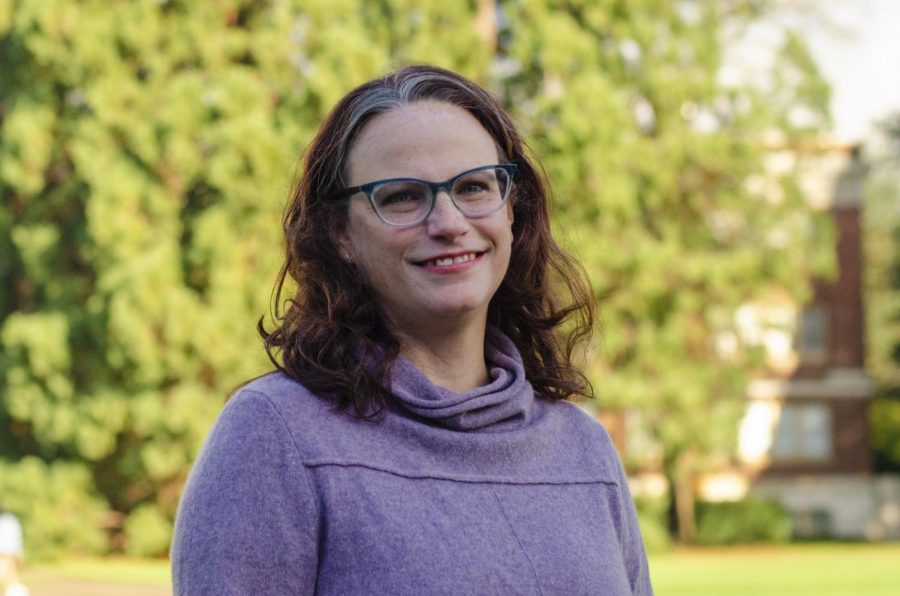Tenure-track process more difficult for caregivers and parents, OSU faculty report
December 6, 2020
In the United States, women are less likely than men to achieve tenure.
In 2018, women in the U.S. held 49.7% of all tenure-track positions (assistant professor, associate professor) but only held 39.3% of tenured positions (full professor). Breaking that down further, women in academia represented 52.9% of assistant professors and 46.4% of associate professors but accounted for only 34.3% of professor positions in the same year.
A national issue, the underrepresentation of women in tenure positions, is also prevalent at Oregon State University. In the fall of 2019, women represented 55.2% of instructor positions at OSU, but only 37% of tenure-track and tenure positions.
Associate professor in the Department of Fisheries and Wildlife and Extension Wildlife Specialist Dana Sanchez said, “No matter who you are or how you identify, as one of my mentors described it, ‘it’s just a really tough slog.’”
Those who go through the tenure-track process are constantly learning new concepts, training, prepping and teaching courses, conducting and seeking funding for research, all while preparing for their midterm and final tenure reviews.
“It’s a compressed amount of time of very hard work, a lot of deep learning,” Sanchez said.
Though the tenure-track process is difficult for everyone, there are additional pressures and challenges that may arise based on how people identify.
Sanchez pointed to caregiving and parenting as a couple of the main reasons that lead to less women becoming tenured.
“Generally, in American society, there’s still a great difference in who does the caregiving,” Sanchez said.
This statement is reflected in the statistics. According to a report by the American Association of Retired Persons, women represented 61% of caregivers in May 2020.
A report from YaleGlobal in 2018 showed that in every region studied, including the U.S., women spent more than twice as much time as men on housework and family care.
Because these responsibilities tend to fall on females more often, women are faced with less time to focus on their tenure goals and more emotional labor, which can increase their stress levels and leave them more exhausted than those who are not expected to provide care or parent others.
COVID-19, according to Sanchez, has exacerbated the difficulty between balancing parenting and work.
“Parents are being expected to homeschool and/or help supervise school-guided curricula for their children of potentially multiple different ages and stages of their educations, while they’re lecturing, attending required meetings, writing their articles, writing their grants,” Sanchezsaid.
Other identities contribute to varying levels of difficulty on the tenure-track ladder.
“The complexities of intersecting identities can make that tenure climb that much more challenging,” Sanchez explained. “It’s not at all unusual— in fact it’s quite common— for people from underrepresented races, ethnicities, cultures, orientations, LGBTQ+ status, communities, even differences in abilities, that are visible or not visible. Across any of those complex and intersecting identities, if there are very few in the community, they tend to get targeted to represent huge slews of people.”
Often, these people are asked to mentor and advocate for the larger group that their identity may represent, which occupies time and takes an emotional and mental toll.
“It is just a difficult process, and anything that exerts pressure, the pressure will always fall more heavily on those who have multiple responsibilities in addition to their work,” Sanchez said.
Tiffany Garcia, a professor in the Department of Fisheries and Wildlife, agreed that though the tenure-track process is difficult for everyone, different identities can affect a person’s experience.
“Tenure is incredibly challenging,” she said. “It’s a tough time in an academic’s career, and that’s across pretty much everybody that’s ever done this. It’s a lot of intrinsic and extrinsic pressures. It’s do or die, make or break. If you don’t get tenure, you’re out.”
Garcia explained that tenure was initially created in a male-dominated world in which women helped at home. This gave the person trying to achieve tenure more time and mental and emotional capacity to reach their goal. But these dynamics have since changed.
“That’s just not the way it is for any of the sexes right now,” Garcia said.
Though everyone faces the pressure of balancing work and life, Garcia said, “What I do think women have that’s disproportionate in terms of a very painful reality, is that tenure happens at the same time as we’re kind of ending our reproductive abilities.”
Essentially, according to Garcia, the tenure process and the timing of women’s prime reproductive abilities directly overlap.
In the past, women have been faced with an either,or decision, forced to choose between having children or having a career. According to Garcia, women in academia have become more creative with avoiding this choice: for example, many will have kids during graduate school or their postdoctoral, or some universities will allow them to stop the “tenure-clock” to bear children.
OSU’s two most significant problems with women on the tenure-track, in Garcia’s opinion, are the lack of childcare and maternity leave.
According to a report from OSU’s College of Public Health and Human Sciences, Oregon is only home to three counties that are not considered child care deserts for children five and under. A child care desert “is defined as a county with more than three young children for every child care slot.”
For Benton County, less than 25% of child care slots are publicly funded, meaning many of the options are privately-funded and expensive.
“That’s a problem the university’s been trying to deal with, and I know several people who have made it their life mission to make it better,” Garcia said, “but it’s not happening fast enough.”
Garcia said that paid parental leave through OSU is also sparse. Parental leave remains an issue across the U.S..
The Family Medical Leave Act (FMLA) grants 12 weeks of unpaid protected job leave on the federal level, but 40% of women do not qualify for it. Oregon passed a paid family and medical leave law in 2019, making it required for the state’s employers to provide up to 12 weeks of paid family and medical leave.
The U.S. remains one of the only high-income countries to not offer paid parental leave on a federal level. Countries like Finland and Denmark provide more time for this form of leave, giving seven months and four and a half months, respectively.
“That is atrocious on every level, and it sets the U.S. apart from pretty much every other place in the world,” Garcia said. “And academics, where you would think it would be better here than in, say, the corporate, private sector, simply not true actually, and it’s almost worse. And it comes down to the university instead of a larger kind of system to decide whether that’s going to happen.”
Both Sanchez and Garcia said that they are hopeful about the future for women in tenure, despite the challenges the process poses.
“I think it’s good that OSU, like some other institutions, is at least stepping up and saying ‘yeah, we need to meet this need,’” Sanchez said.
Garcia has thought about solutions and suggested, “Perhaps we need to start thinking about, you know, more progressive ways of getting tenure that doesn’t involve putting everything in your life aside for five years.”
Garcia continued, “It’s really a cultural thing. The culture is what needs to shift. It needs to be more inclusive; it needs to be more accepting.”
Garcia said she is starting to see things change within the tenure-track process.
Garcia said that she is noticing more “people who are putting real value on the other parts of their life,” thus creating a culture of change.
“I love my job, and I don’t want people to be scared of this culture of overworking, because we can be the change,” she said. “We just need to be the change we want to see.”












































































































